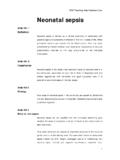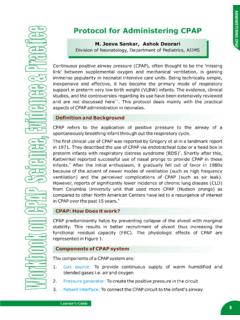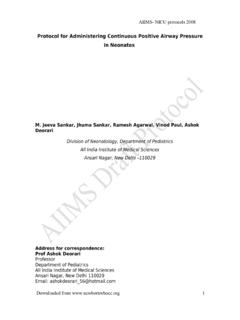Transcription of Hypocalcemia in the Newborn
1 Hypocalcemia in the Newborn Rajiv Aggarwal, Manas Upadhyay, Ashok K Deorari, Vinod K Paul Division of Neonatology, Department of Pediatrics All India Institute of Medical Sciences Ansari Nagar, New Delhi 110029. Address for correspondence: Dr Ashok K Deorari Additional Professor Department of Pediatrics All India Institute of Medical Sciences Ansari Nagar, New Delhi 110029. Email: 2. Abstract Healthy term babies undergo a physiological nadir in serum calcium levels by 24-48. hours of age. This nadir may be related to the delayed response of parathyroid and calcitonin hormones in a Newborn . This nadir may drop to hypocalcemic levels in high- risk neonates including infants of diabetic mothers, preterm infants and infants with perinatal asphyxia. This early onset Hypocalcemia which presents within 72 hours, requires treatment with calcium supplementation for at least 72 hours. In contrast late onset Hypocalcemia usually presents after 7 days and requires long term therapy. Ionized calcium is crucial for many biochemical processes and total serum calcium is a poor substitute for the diagnosis of Hypocalcemia .
2 3. Hypocalcemia in the Newborn period Introduction During the 3rd trimester, calcium is transferred from mother to the fetus by active transport. Serum calcium in the fetus is 10-11 mg/dl at term (1-2 mg higher as compared to mother). Parathyroid hormone (PTH) and Calcitonin (CT) do not cross the placental barrier. After delivery, calcium levels start decreasing and reaches a nadir of mg/dl in healthy term babies, by day 2 of life. The drop in postnatal serum calcium may be related to the peak in calcitonin level, which occurs by 12-24 hours of age. PTH levels increase gradually in the first 48 hours of life and normal levels of serum calcium are regained by day 3 of life. This transition process is responsible for the increased risk of early onset Hypocalcemia in high-risk neonates. Calcium homeostasis in Newborn Body calcium exists in two major compartments; (a) Skeleton (99%) and (b). Extracellular fluid (1%). Calcium in the extracellular fluid is present in 3 forms: (a).
3 Bound to albumin (40%) (b) bound to anions like phosphorus, citrate, sulfate and lactate (10%) and (c) free ionized form (50%). Ionized calcium is crucial for many biochemical processes including blood coagulation, neuromuscular excitability, cell membrane integrity and function, and cellular enzymatic and secretory activity. Estimation of total calcium levels is a poor substitute for measuring the ionized levels. Definition 4. Hypocalcemia is defined as total serum calcium <7 mg/dl or ionized calcium < 4mg/dl. The values in mg/dl may be converted to molar units (mmol/L) by dividing by 4. Early onset Neonatal Hypocalcemia (ENH). This condition is fairly common and seen within the first 3 days of life. Prematurity: Preterm babies born at a gestation 32 weeks are at an increased risk of ENH in the first 3 days of postnatal life. This may be related to premature termination of trans-placental supply, exaggeration of the postnatal drop to hypocalcemic levels and diminished target organ responsiveness to parathyroid hormone.
4 Infant of diabetic mother: (gestational and insulin dependent). This may be related to increased calcium demands of a macrosomic baby. Perinatal asphyxia: Hypocalcemia and hyperphosphatemia in this condition may be related to renal insufficiency, metabolic acidosis and diminished parathyroid hormone secretion. Small for gestational age is not an independent risk factor for ENH. Screening is recommended in at-risk neonates: 1. Preterm infants ( 32 weeks). 2. Infant of diabetic mothers 3. Severe perinatal asphyxia defined as Apgar score <4 at 1 minute of age. Screening for Hypocalcemia is not needed in small for gestational age (SGA) infants unless additional risk factors like asphyxia are present. Time schedule for screening: 5. At 24 and 48 hours in high-risk babies Clinical presentation: 1. Asymptomatic: Early onset Hypocalcemia is usually asymptomatic unlike the late onset variety and is diagnosed on routine screening. 2. Symptomatic: The symptoms are neither specific nor related to the severity of Hypocalcemia .
5 These include jitteriness, lethargy, apnea, hypotonia, high-pitched cry, stridor, irritability and seizures Diagnosis 1. Laboratory: Total or ionized serum calcium (total <7 mg/dL or ionized < mg/dL). Ionized calcium is the preferred mode for diagnosis of Hypocalcemia . 2. ECG: QoTc > seconds or QTc > seconds QTc = QT interval in seconds R-R interval in seconds QoTc = QoT interval in seconds R-R interval in seconds (QT interval is measured from origin of q wave to end of T wave on ECG. QoT interval is measured from origin of q wave to origin of T wave). 6. A diagnosis of Hypocalcemia based only on ECG criteria is likely to yield a high false positive rate. Neonates suspected to have Hypocalcemia by ECG criteria should have the diagnosis confirmed by measurement of serum calcium levels. Treatment: (1 ml of calcium gluconate (10%) gives 9 mg of elemental calcium). 1. Patients at increased risk of Hypocalcemia : Preterm infants ( 32 weeks), sick infants of diabetic mothers and those with severe perinatal asphyxia should receive 40 mg/kg/day of elemental calcium (4 ml/kg/day of 10% calcium gluconate).
6 Infants tolerating oral feeds may receive this calcium orally q 6. hourly. Therapy should be continued for 3 days. 2. Patients diagnosed to have asymptomatic Hypocalcemia : Infants detected to have Hypocalcemia on screening and who are otherwise asymptomatic should receive 80-mg/kg/day elemental calcium (8 ml/kg/day of 10% calcium gluconate) for 48. hours. This may be tapered to 50% dose for another 24 hours and then discontinued. Neonates tolerating oral feeds may be treated with oral calcium (IV. preparation may be used orally). 3. Patients diagnosed to have symptomatic Hypocalcemia : These patients should receive a bolus dose of 2 ml/kg/dose diluted 1:1 with 5% dextrose over 10. minutes, under cardiac monitoring. This should be followed by a continuous IV. infusion of 80-mg/kg/day elemental calcium for 48 hours. Continuous infusion is preferred to IV bolus doses (1ml/kg/dose q 6 hourly). Calcium infusion should be dropped to 50% of the original dose for the next 24 hours and then discontinued.
7 7. The infusion may be replaced with oral calcium therapy on the last day. Normal calcium values should be documented at 48 hours before weaning the infusion. All categories of Hypocalcemia should be treated for at least 72 hours. Continuous infusion is preferred to IV bolus doses. Symptomatic Hypocalcemia should be treated with a continuous infusion for at least 48 hours. Precautions and side effects Bradycardia and arrhythmia are known side effects of bolus IV calcium administration and bolus doses of calcium should be diluted 1:1 with 5% dextrose and given under cardiac monitoring. An umbilical venous catheter (UVC) may be used for administration of calcium only after ensuring that the tip of the catheter is in the inferior vena cava. Hepatic necrosis may occur if the tip of the UVC lies in a branch of the portal vein. Umbilical artery catheter (UAC) should never be used for giving calcium injections. Accidental injection into the UAC may result in arterial spasms and intestinal necrosis.
8 Skin and subcutaneous tissue necrosis may occur due to extravasation. Hence IV sites where calcium is being infused should be checked at least q 6 hourly to monitor for extravasation and avoid subcutaneous tissue necrosis. Prolonged or resistant Hypocalcemia : This condition should be considered in the following situations: Symptomatic Hypocalcemia unresponsive to adequate doses of calcium therapy Infants needing calcium supplements beyond 72 hours of age Hypocalcemia presenting at the end of the first week. 8. These infants should be investigated for causes of LNH (see below). 2. Late onset neonatal Hypocalcemia (LNH). This condition is rare as compared to ENH. It usually presents at the end of the first week It is usually symptomatic in the form of neonatal tetany. The causes are listed in table 1. Investigations These should be considered in LNH or if the Hypocalcemia does not respond to adequate doses of calcium. Serum magnesium: Magnesium levels < mg/dL should be treated Serum phosphate (P): Phosphate levels are increased in renal failure, top feeding with cow's milk and hypoparathyroidism.
9 Alkaline phosphatase (ALP): ALP levels are increased in hypoparathyroidism PTH levels: PTH is decreased in hypoparathyroidism. Urine calcium/ creatinine ratio: Ratio > is suggestive of hypoparathyroidism Chest x-ray: Absence of thymus is suggestive of DiGeorge syndrome Maternal calcium, phosphate and alkaline phosphatase levels: These would be helpful in detection of maternal vitamin D deficiency Treatment of LNH. The treatment of LNH is specific to etiology and may in certain diseases be life-long 1. Hypomagnesemia: Symptomatic Hypocalcemia unresponsive to adequate doses of IV. calcium therapy is usually due to hypomagnesemia. It may present either as ENH or later as LNH. The neonate should receive 2 doses of of 50% MgSO4 injection, 12. 9. hours apart, deep IM followed by a maintenance dose of ml/kg/day of 50% MgSO4, PO, 3 days. 2. High phosphate load: These infants have hyperphosphatemia with near normal calcium levels. Exclusive breast-feeding should be encouraged and top feeding with cow's milk should be discontinued.
10 Phosphate binding gels should be avoided. 3. Hypoparathyroidism: These infants tend to be hyperphosphatemic and hypocalcemic with normal renal functions. Elevated phosphate levels in the absence of exogenous phosphate load (cow's milk) and presence of normal renal functions indicates parathormone inefficiency. These neonates need supplementation with calcium (50. mg/kg/day in 3 divided doses) and 1,25(OH)2 Vitamin D3 ( g/day). Syrup Shelcal has 250 mg/5ml of calcium and Vitamin D3 (calcitriol) is available as g capsules. Therapy may be stopped in Hypocalcemia secondary to maternal hyperparathyroidism after 6 weeks. 4. Vitamin D deficiency states: These babies have Hypocalcemia associated with hypophosphatemia due to an intact parathormone response on the kidneys. They benefit from Vitamin D3 supplementation in a dose of 30-60 ng/kg/day References: 1. Oden J, Bourgeois M. Neonatal endocrinology. Indian J Pediatr 2000;67:217-23. 2. Schwartz R, Teramo KA. Effects of diabetic pregnancy on the fetus and Newborn .






